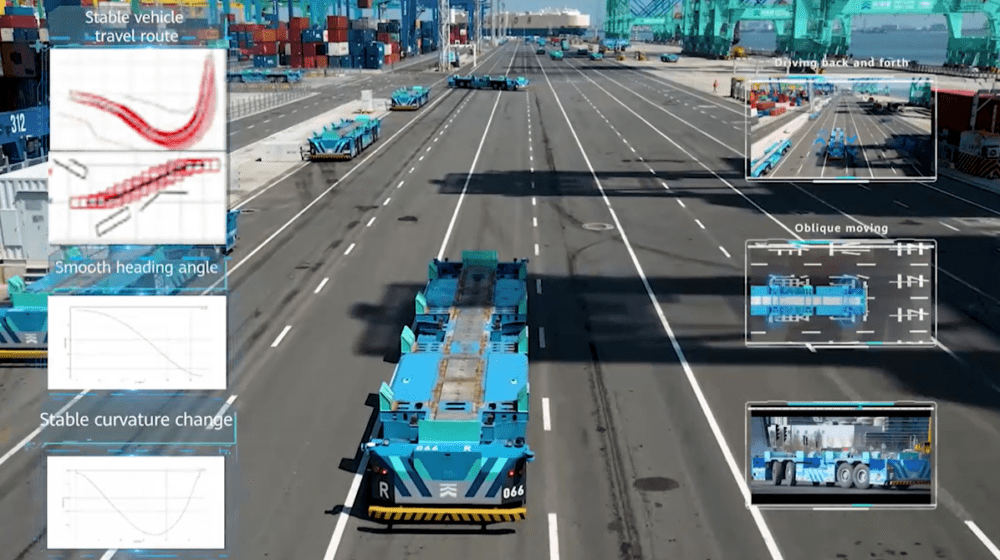 Demonstration of possible use cases with Huawei 5G in Tianjin Port (Huawei)
Demonstration of possible use cases with Huawei 5G in Tianjin Port (Huawei)
5G connection in ports sector: an important step towards digitalization
5G service is creating high expectations in many sectors, due to its technical improvements compared to the previous connections. Ports sector is one of the most interested in its implementation, and many authorities are already working on it.

Chiara Saragani is a researcher at CENIT and PhD student in digitalization at the Port of Barcelona.
 Demonstration of possible use cases with Huawei 5G in Tianjin Port (Huawei)
Demonstration of possible use cases with Huawei 5G in Tianjin Port (Huawei)
WHY 5G IS SO INTELLIGENT?
5G connection will improve the current 4G with respect to three main factors, which are speed, capacity and latency.
Concerning the speed, it is expected that 5G will be more than 100 times faster than 4G. As a consequence, data download time will decrease significantly, making the entire system faster and more reactive.
Moreover, 5G capacity will be up to 1000 times the 4G one, providing high quality of service even with a higher number of connected users.
Finally, latency - which is the delay rate for moving data between the source and its destination - will be 5 times less than the 4G service. Lower values are possible thanks to Edge Computing, which aims to process data close to the device that generate it, without sending the information to a central server.
Latency, which is one of the factors that determines the quality of the interconnection between different entities, is considered decisive for many IoT applications.

The advantages provided by the 5G service could be used in many sectors and ports is one of them. More specifically, the new connection of a Port system would ensure the following requirements:
- Reliability, availability and resilience: the new connection would guarantee a correct and continuous operability and it would be able to minimize the downtime in case of both expected and unexpected service outages.
- Flexibility: it would be capable to easily adapt the current system with possible technical updates which could be applied for improving the service.
- Scalability: both hardware and software architectures would be planned in order to be open to possible future expansions of demand and also new functionalities.
- Security and isolation: high levels of security from cyberattacks and confidence for data privacy would be taken into account.
DIFFERENT TYPES OF INSTALLATION OF 5G SERVICE
5G could be a private, public or hybrid network. The differences between the three of them are based on different ways of managing the entire system.
The public connection offers a high-speed connectivity and the possibility to everyone to get access to the service. However, it is less easy to control the entire system so it would be more vulnerable.
The private 5G ensures more security due to the limited access to the network to just people belonging to the interested environment. On the other hand, the installation process and maintenance costs are more expensive.
Finally, the hybrid connection tries to take the advantages of both previous options, using both private and public networks for distinct activities. This diversification helps to reduce the risk of downtimes, but managing the entire system could be more complex.
| Private connection | Public connection | Hybrid connection | |
| The service is owned by the Port Authority. | The service is owned by telecommunications companies. | The Port Authority uses both private and public network. | |
| Pros | More secure system compared to public service. | High speed connection. | More flexible system. |
| Lower levels of transmission latency. | The network is accessible to everyone. | Cost reduction compared to the private service. | |
| More control over network performance. | Data storage and processing carried by Edge Computing. | More secure than public connection. | |
| High levels of capacity. | Less costs for the Port Authority. | Ability to optimize the most important activities using the private network. | |
| Cons | It is more expensive. | More vulnerable system. | Managing the network is more complex. |
| The connection is limited to a specific area. | Not so much control on the exchanged data. |
The features and advantages of 5G over 4G could be exploited in many sectors, and the port sector is no exception
MANY PORTS ARE WORKING ON 5G INSTALLATION
There are different ports already involved in 5G installations as a starting point for new activities.
Huawei already tested its 5G connection in Ningbo-Zhoushan Port. The program was developed with China Mobile Ningbo and China Mobile Shanghai Industrial Research Institute. The new service could improve the efficiency of the logistics activities in port’s terminals, promoting with new systems different tasks, like autonomous driving fleets, container positioning improvement and charging management system.
Moreover, many trials in other Chinese ports are conducting, like Guangzhou Port, Tianjin Port and Qingdao Port, and it is expected to collaborate with other entities sooner.
Furthermore, the Port of Singapore has already signed a Memorandum of Understanding with Infocomm Media Development Authority (IMDA) to develop a 5G mobile network, and the total coverage is expected by 2025. The aim of the project is the creation of a robust and fast ecosystem in order to guarantee real-data exchange in maritime activities.
The Hamburg Port Authority has already planned the future use cases of the 5G-MoNArch project. This one is funded by the European Commission and it will take advantage of 5G installation for the application of three main use cases, which are:
- Management of traffic lights of the port in order to reduce congestion.
- 5G technology and virtual/ augmented reality for improving port operations.
- Better control of pollution using sensors on barges for its measurement.
The project aims to expand the Phase 1 of the 5G-PPP project, in which a conceptual framework of the 5G infrastructure was created.

In addition, the Port of Livorno is installing the private 5G connection thanks to the collaboration with TIM and Ericsson. The project will have a first pilot with one of the Grimaldi new vessels. More specifically, the Port will exchange different types of data with the vessels, both connected to the new connection service.
One of the current projects is COREALIS, which considers 5G connection for managing general cargo operations inside the terminal. The project aims to optimize intra-terminal operations, thanks to the installation of 5G network and the use of AR/VR-based services.
The Belfast Harbour is also implementing its private 5G network, thanks to the collaboration with BT. The new service will help to accelerate the digital transformation through the implementation of many innovations, like AI, IoT, Connected Autonomous Vehicles.
Finally, the Port of Barcelona has already planned a hybrid 5G service which will cover the entire Port. The new connection will be used for improving many activities and it will be the baseline scenario for the development of one of the work packages of the PIONEERS project. In addition, new cameras will be placed in port’s boundaries and their interconnection will be guaranteed by the new connection.
The previous applications are part of a detailed plan that the Port of Barcelona has defined, concerning future use cases with 5G implementation for the next five years.
MARITIME 5G: PIONEERS PROJECT
One of the work packages of the overall project considers the Maritime 5G. The project is led by the Department of Innovation of the Port of Barcelona and the Center for Innovation in Transport (CENIT), which is a research group of CIMNE and also a member of PIONEERS.
The aim of the project is the use of 5G for the detection of vessels positioning within the Port, considering both big and small ships. The 5G service will ensure the interconnection of real time information coming from smart cameras. The previous ones will monitor vessels flows capturing their movements in port’s boundaries. Finally, an artificial intelligence algorithm will elaborate data in order to create the final information.
The development of this technology will create a new location system based on real time information and it will encourage the improvement of logistics activities. Its first demonstration is expected in 2024, during the America’s Cup which will take place in Barcelona.
The previous use cases would promise high expectations with the 5G implementation. Each port is working on different activities, but they all have a unique final objective: to improve port efficiency.
Will these projects be enough to justify the huge investment? How many other things could be done with the new intelligent network?






